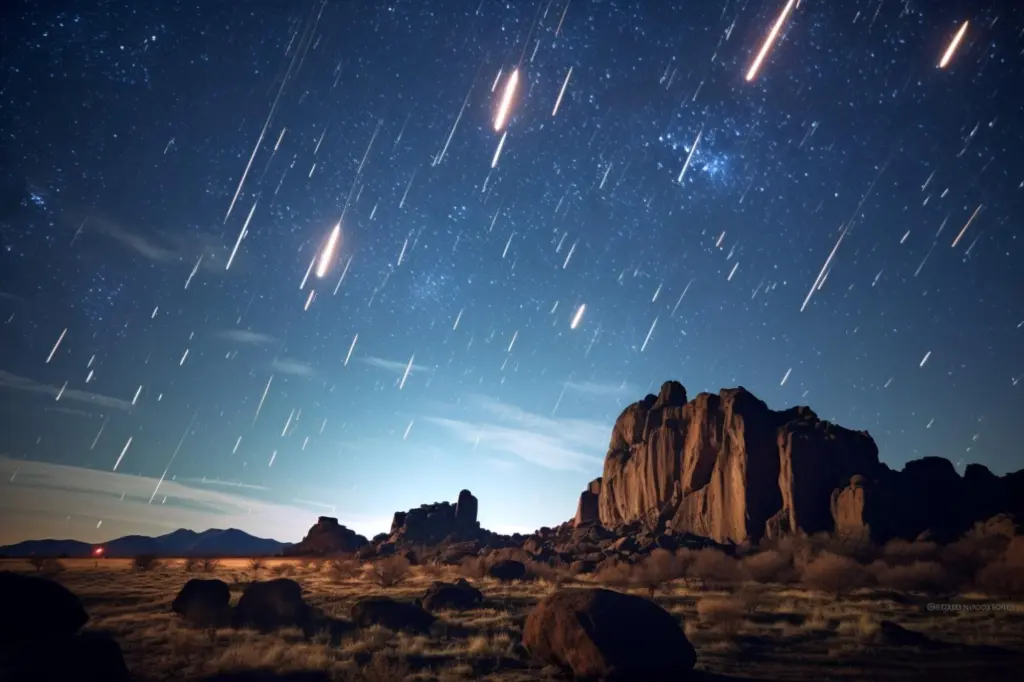
Stunning 2025 Meteor Showers Are Coming: 2025 Meteor Showers are lighting up the skies all year long, and if you’ve ever wanted to catch a real-deal shooting star, now’s the time to plan your night under the cosmos.
Whether you’re a first-time stargazer, a science teacher looking for a classroom-friendly project, or a die-hard astrophotographer, this guide is for you. We’ll walk you through the best meteor showers in 2025, how to watch them, where to go, and even how to photograph them. Let’s break down everything you need to know to experience the biggest celestial fireworks show Earth has to offer.
Stunning 2025 Meteor Showers Are Coming
2025 is shaping up to be one of the best years in recent memory for meteor watchers. With ideal moon phases aligning for major showers like the Geminids, Eta Aquariids, and Orionids, there’s a golden opportunity to witness the sky in motion. You don’t need to be an expert or own fancy gear—just get outside, look up, and enjoy the wonder. And remember, every shooting star you catch is a tiny piece of space dust, burning up in Earth’s atmosphere after millions of years traveling through the cosmos. So grab a chair, bring a friend, and keep your eyes to the sky. The universe has a show planned just for you.
| Meteor Shower | Peak Date(s) | Meteors per Hour (ZHR) | Best Viewing Locations | Moon Conditions |
|---|---|---|---|---|
| Quadrantids | Jan 3–4 | 25–120 | Northern U.S., Canada, Europe | Crescent moon |
| Lyrids | Apr 21–22 | 10–20 | U.S. Southwest, Central Asia | Waning crescent |
| Eta Aquariids | May 5–6 | 40–50 | Australia, South America, Africa | Low moonlight |
| Southern Delta Aquariids | Jul 29–30 | 20–25 | Southern Hemisphere | Waxing crescent |
| Perseids | Aug 12–13 | 60–100+ | U.S. Rockies, Canada, Northern Europe | Gibbous moon |
| Orionids | Oct 21–22 | 15–20 | Northern Hemisphere | New moon—ideal |
| Leonids | Nov 17 | 10–15 | Worldwide | Waning moon |
| Geminids | Dec 13–14 | 75–150 | Northern Hemisphere | Waning crescent—excellent |
| Ursids | Dec 21–22 | 5–10 | Northern Hemisphere | Minimal moonlight |
*ZHR = Zenith Hourly Rate under ideal conditions.
What Causes Meteor Showers?
Meteor showers happen when Earth moves through clouds of debris left behind by comets or, in rare cases, asteroids. These tiny particles hit Earth’s atmosphere at very high speeds—anywhere from 25,000 to over 150,000 miles per hour—and burn up, producing bright streaks across the sky.
Each meteor shower is named after the constellation it appears to radiate from. For example:
- Perseids radiate from the constellation Perseus.
- Geminids come from Gemini.
- Orionids from Orion.
Contrary to what some folks think, the stars themselves aren’t moving—Earth is.
The Cultural Significance of Meteor Showers

Meteor showers have fascinated humans for thousands of years.
- Native American tribes, like the Lakota and Ojibwe, saw meteors as messages from ancestors or spirit warriors.
- In ancient Greece, meteors were called “falling stars” and thought to be omens sent by gods.
- Chinese astronomers as early as 36 BCE recorded meteor showers in imperial logs.
Today, meteor showers continue to inspire curiosity, art, and science alike. They’re an ideal moment to slow down, look up, and remember our place in the universe.
How to Watch Stunning 2025 Meteor Showers Are Coming: Step-by-Step Guide
Watching a meteor shower is simple, but following a few steps can make the experience a lot more enjoyable and successful.
1. Find a Dark Sky Location
Avoid city lights. Choose a rural park, desert, mountain, or certified dark sky preserve.
2. Check the Moon Phase
Moonlight can drown out faint meteors. For peak visibility, go out when the moon is in its crescent or new phase.
3. Go Out at the Right Time
The best time to view most meteor showers is between midnight and dawn, when the sky is darkest and Earth is rotating into the meteor stream.
4. Let Your Eyes Adjust
It takes 20–30 minutes for your eyes to fully adapt to the dark. Avoid looking at phone screens—if you need to, use red light mode.
5. Get Comfortable
Bring a reclining chair, blanket, or even a sleeping bag. Dress in layers—especially for winter shows like the Geminids or Quadrantids.

Tools & Apps to Help You Track Meteor Showers
Here are a few must-have apps and websites to elevate your skywatching experience:
| App / Website | Features |
|---|---|
| SkySafari | Live tracking, star maps, meteor events |
| Stellarium | 3D planetarium and star locator |
| Heavens Above | Tracks satellites and meteor showers |
| Clear Outside | Weather forecasting for astronomers |
| Star Walk 2 | Sky map with AR features |
Photography Tips: Capturing Meteor Showers
For DSLR or Mirrorless Cameras:
- Use a wide-angle lens (14mm to 24mm).
- Set aperture to f/2.8 or wider.
- Set ISO to 1600–3200.
- Shutter speed: 20–30 seconds.
- Focus manually to infinity.
- Use a tripod and interval timer or remote shutter release.
For Smartphones:
- Use Pro Mode if available.
- Use apps like NightCap (iOS) or Camera FV-5 (Android).
- Stabilize phone using a tripod or mount.
Meteor photography is a game of patience—expect to shoot dozens of frames to capture that one perfect trail.
Safety & Comfort Checklist
| Item | Purpose |
|---|---|
| Warm clothing | Night temperatures can drop significantly |
| Blanket or sleeping bag | Keeps you cozy for long sessions |
| Reclining chair | Avoid neck strain |
| Bug spray | Essential for summer watching |
| Thermos with drinks | Keeps you hydrated and warm |
| Star map or app | Know what constellations you’re seeing |
| Red flashlight | Preserves night vision |
| Power bank | For phones or star-tracking apps |
Best U.S. & Global Viewing Locations

In the U.S.
- Cherry Springs State Park (PA) – International Dark Sky Park
- Great Basin National Park (NV) – Desert skies and high altitude
- Big Bend National Park (TX) – Little light pollution
- Flagstaff, Arizona – First International Dark Sky City
- Death Valley (CA/NV) – Remote and moon-like
Worldwide
- Wadi Rum, Jordan – Called the “Valley of the Moon”
- Atacama Desert, Chile – One of the driest places on Earth
- Western Australia Outback – Massive horizons, minimal cloud cover
- Namib Desert, Namibia – Stunning views and dry nights
For Families, Educators, and Creators
Parents: Meteor showers are a great way to introduce your kids to science, nature, and storytelling.
Teachers: Plan a school-wide stargazing night or use it as part of a lesson on space and astronomy.
Content Creators: Capture timelapse videos, make educational reels, or host live meteor watches on YouTube, TikTok, or Instagram.
Encouraging hands-on science experiences like this supports STEM learning, curiosity, and environmental awareness.
NASA Just Discovered Solar Curtains on the Sun—Here’s How This Plasma Spectacle Forms
Voyager 1 Sends Back Shocking Data—This Discovery Could Rewrite Everything We Know About Space
Frequently Asked Questions (FAQs)
Q: Can I see meteor showers without special equipment?
Yes! The human eye is the best tool. Telescopes and binoculars can actually hinder your experience.
Q: Are meteor showers dangerous?
No. These particles burn up high in Earth’s atmosphere. They’re beautiful to watch but completely safe.
Q: How long does a meteor shower last?
While some last for weeks, the best time is usually within 1–2 days of the peak. The number of visible meteors can vary based on weather and moonlight.
Q: Can I see meteor showers from a city?
You can see the brightest meteors, but light pollution will block most of the show. Travel to a dark-sky area if possible.











